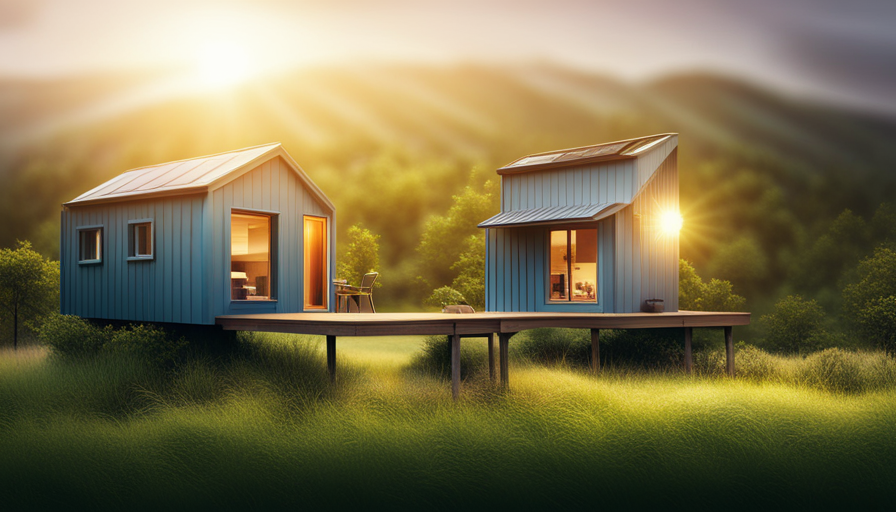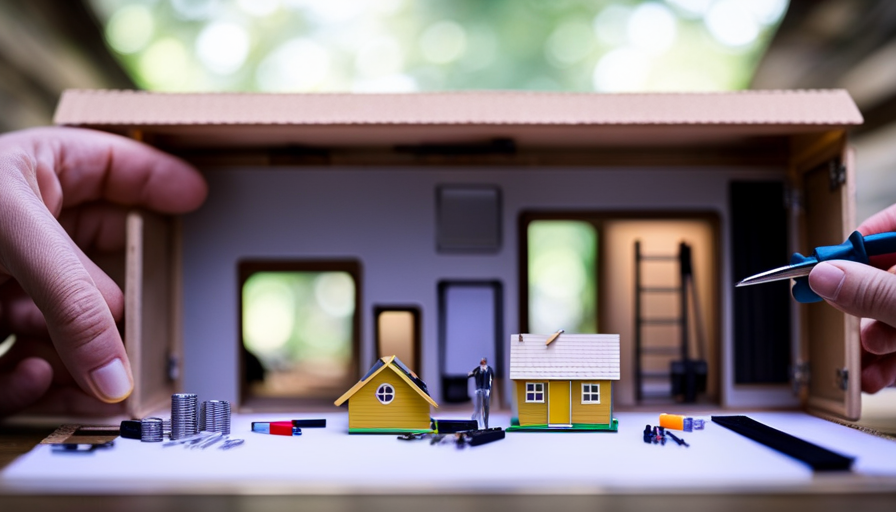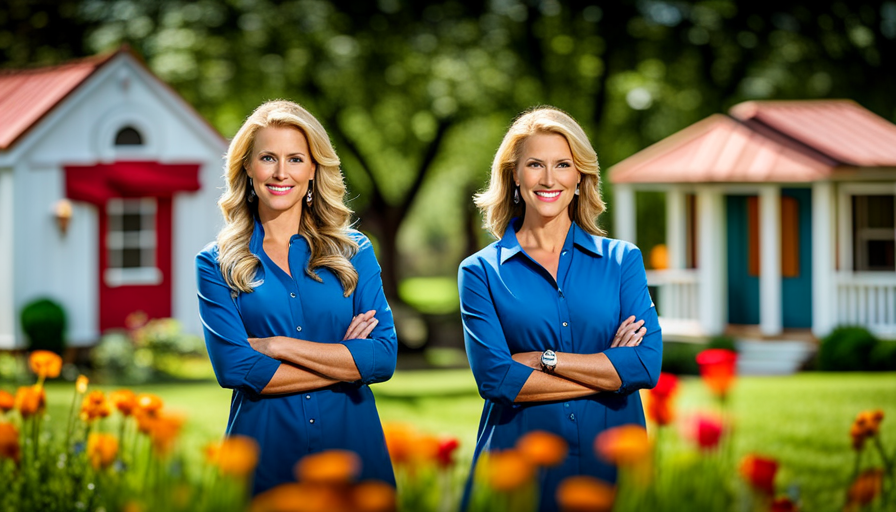Enter the world of tiny houses, where small dwellings hold big dreams. Join us on a journey exploring how these compact homes minimize energy usage.
Like a hummingbird sipping nectar from a flower, tiny houses gracefully sip electricity to power their essential needs.
In this article, I will guide you through the intricacies of understanding and optimizing energy usage in tiny houses. We will explore the factors that influence this consumption, calculate average energy needs, and debunk common myths surrounding it. Through real-life case studies, we will witness the awe-inspiring feats of energy-efficient dwellings.
Living sustainably is not just an aspiration; it is a responsibility towards our planet. By embracing low-energy housing options like tiny houses, we can significantly reduce our carbon footprint and contribute to a greener future.
So join me as we uncover the secrets behind how many kilowatts (KW) a tiny house uses. Together, we will unlock the power of knowledge and empower ourselves to make informed choices for sustainable living.
Key Takeaways
- Factors influencing energy consumption in tiny houses include house size, insulation, and the type of appliances used.
- Strategies for saving energy in tiny houses include proper insulation, energy-efficient windows and doors, and the use of energy-efficient appliances and renewable energy sources.
- Energy efficiency factors in tiny houses include design, construction materials, and the use of renewable energy sources.
- Transitioning to sustainable living through tiny houses can help reduce carbon footprint and contribute to sustainable living.
Understanding Tiny House Energy Consumption
You might be wondering how much power a tiny house actually uses. Well, let’s dive into the world of tiny house energy consumption.
There are several factors that influence energy usage in these small dwellings. First and foremost is the size of the house itself. Tiny houses typically range from 100 to 400 square feet, so they require significantly less energy compared to traditional homes.
Another important factor is insulation. Proper insulation helps to regulate temperature inside the tiny house, reducing the need for heating or cooling appliances and consequently saving energy. Additionally, efficient windows and doors play a crucial role in minimizing heat transfer.
The type of appliances used also affects energy consumption. Energy-efficient appliances like LED lights, low-flow water fixtures, and ENERGY STAR-rated electronics can significantly reduce overall power usage.
Furthermore, renewable energy sources such as solar panels or wind turbines are increasingly popular among tiny homeowners as they provide sustainable electricity while reducing dependence on the grid.
There are several strategies that can help save energy in a tiny house: proper insulation, use of energy-efficient appliances, and harnessing renewable energy sources.
In the next section, we will explore in detail the factors that influence energy usage in tiny houses without repeating what has already been discussed thus far.
Factors that Influence Energy Usage in Tiny Houses
One interesting statistic is that the size of a tiny house directly affects its energy consumption. There are several factors that influence the energy usage in tiny houses, which can be categorized into two main categories: factors affecting energy efficiency and cost-saving strategies.
Firstly, the design and construction materials used in a tiny house play a significant role in its energy efficiency. Proper insulation, high-quality windows, and efficient heating and cooling systems can greatly reduce energy consumption. Additionally, incorporating renewable energy sources such as solar panels or wind turbines can further maximize energy efficiency.
Secondly, lifestyle choices and daily habits also impact the amount of energy consumed in a tiny house. Being mindful of electricity usage by turning off lights when not needed and using energy-efficient appliances can contribute to significant savings. Furthermore, adopting sustainable practices like composting or using rainwater for gardening can help reduce overall water and energy usage.
By considering these factors affecting energy efficiency and implementing cost-saving strategies, owners of tiny houses can minimize their environmental footprint while enjoying comfortable living spaces that require minimal amounts of energy.
In the next section about calculating the average energy consumption of a tiny house, we will delve into specific methods to determine the precise amount of kilowatts used by these compact dwellings without compromising on modern amenities.
Calculating the Average Energy Consumption of a Tiny House
To calculate how much energy your tiny home consumes on average, start by examining its daily habits and lifestyle choices. The key to accurately estimating energy consumption is to consider all the factors that contribute to it.
Begin by assessing the types of appliances and electronics in your tiny house. Energy-efficient appliances can significantly reduce power usage, so make sure to invest in those with high Energy Star ratings.
Next, evaluate the insulation and weatherization of your home. Properly insulated walls, windows, and doors can prevent heat loss or gain, reducing the need for heating or cooling systems. Additionally, consider implementing smart technology such as programmable thermostats or motion sensors that automatically turn off lights when not in use. These small adjustments can greatly impact energy costs over time.
By calculating energy costs based on appliance usage and incorporating energy-efficient practices into your daily routine, you can optimize energy efficiency in your tiny house without compromising comfort or convenience.
Now let’s move on to some tips for optimizing energy efficiency in tiny houses…
Tips for Optimizing Energy Efficiency in Tiny Houses
Implementing energy-efficient practices and utilizing smart technology can greatly enhance the efficiency of energy usage in your compact living space. To maximize insulation, start by ensuring that your tiny house is properly sealed to prevent air leakage. Use high-quality insulation materials like spray foam or rigid foam boards to create a tight building envelope.
Additionally, consider installing double-pane windows with low-emissivity coatings to reduce heat transfer.
In terms of appliances, make sure to choose energy-efficient options. Look for appliances with the ENERGY STAR label, as they’re designed to consume less electricity without sacrificing performance. Opt for LED lighting throughout your tiny house, as they use significantly less energy compared to traditional incandescent bulbs.
Another way to optimize energy efficiency is by using smart home technology. Smart thermostats allow you to control and schedule the heating or cooling of your tiny house remotely, ensuring that you only use energy when necessary. Smart power strips can also help eliminate standby power consumption by automatically cutting off power to devices not in use.
By maximizing insulation and using efficient appliances, you can significantly reduce your tiny house’s energy consumption. Transitioning into the subsequent section about common myths about tiny house energy usage, it’s important to debunk misconceptions and provide accurate information on how these small dwellings utilize electricity efficiently without compromising comfort or convenience.
Common Myths about Tiny House Energy Usage
Contrary to popular belief, living in a tiny house doesn’t mean sacrificing comfort or convenience when it comes to energy usage. There are several common myths surrounding the energy consumption of tiny houses that need debunking. One myth is that tiny houses use significantly less electricity than traditional homes. While it’s true that tiny houses have a smaller footprint, they still require power for essential appliances and amenities.
To illustrate this point, let’s take a look at a comparison between the average energy consumption of a tiny house and a traditional home. In the table below, you can see the estimated kilowatt-hours (kWh) used per day for various appliances:
| Appliance | Tiny House (kWh/day) | Traditional Home (kWh/day) |
|---|---|---|
| Refrigerator | 1.5 | 2.5 |
| Air Conditioner | 2 | 4 |
| Lighting | 0.5 | 1 |
| Water Heater | 3 | 6 |
As you can see, while there are some differences in energy usage, the gap isn’t as significant as one might think. Tiny houses still require electricity for essential appliances such as refrigerators and lighting.
In the next section, we will delve further into comparing the overall energy consumption of tiny houses and traditional homes. It is important to consider all factors before making any assumptions about their respective efficiency levels without conducting an in-depth analysis.
Comparing Energy Consumption of Tiny Houses and Traditional Homes
When comparing energy consumption, it’s interesting to note the differences between tiny houses and traditional homes.
Several factors affect the energy usage of a tiny house, making it more efficient than its larger counterpart. Firstly, the smaller square footage of a tiny house means there is less space to heat or cool, resulting in reduced energy needs. Additionally, many tiny houses are designed with energy-saving techniques in mind. These include using high-quality insulation materials to minimize heat transfer and employing double-pane windows to prevent drafts.
Furthermore, tiny houses often utilize renewable energy sources such as solar panels or wind turbines. This not only reduces their reliance on traditional power grids but also helps lower their overall energy consumption. In fact, some well-designed and properly equipped tiny houses can achieve net-zero energy status.
By incorporating these various techniques and technologies into their design and construction, tiny houses can significantly reduce their environmental impact while still providing comfortable living spaces.
Case studies: real-life examples of energy-efficient tiny houses will further illustrate how these strategies have been successfully implemented.
Transitioning into the subsequent section about case studies: real-life examples of energy-efficient tiny houses…
Case Studies: Real-Life Examples of Energy-Efficient Tiny Houses
Transitioning to case studies, we can see real-life examples of how energy-efficient tiny houses have successfully incorporated various techniques and technologies to minimize their environmental impact while still providing comfortable living spaces. These case studies serve as tangible proof that energy-efficient design is not only achievable but also practical for those seeking a sustainable lifestyle.
Here are three remarkable examples:
-
The Eco-Capsule: This innovative tiny house utilizes solar panels and a built-in wind turbine to generate electricity, making it completely self-sufficient. With its rainwater collection system and composting toilet, the Eco-Capsule minimizes water consumption and waste production.
-
The ZeroHouse 2.0: Designed with energy efficiency in mind, this tiny house integrates advanced insulation, high-performance windows, and an air-tight building envelope to reduce heating and cooling demands significantly. Additionally, it features a rooftop solar array that provides renewable energy for all household needs.
-
The Leaf House: Built with reclaimed materials and equipped with Energy Star-rated appliances, this tiny house exemplifies sustainability. Its passive solar design maximizes natural light and heat gain while minimizing energy consumption.
These real-life examples showcase the potential of energy-efficient tiny houses to minimize resource usage without compromising comfort or convenience. By adopting such designs on a larger scale, we can collectively contribute to reducing our carbon footprint and preserving the environment for future generations.
Transitioning into the subsequent section about the ‘environmental benefits of living in a low-energy tiny house,’ we unveil further advantages beyond just reduced energy consumption.
Environmental Benefits of Living in a Low-Energy Tiny House
Living in a low-energy tiny house offers a range of environmental benefits, from reducing greenhouse gas emissions to preserving natural resources and promoting sustainable living. These homes are designed to minimize energy consumption through various energy-saving techniques and the use of green building materials.
One key aspect of low-energy tiny houses is their efficient insulation. By using materials such as cellulose or spray foam insulation, these homes can significantly reduce heat transfer and maintain stable indoor temperatures without relying on excessive heating or cooling systems. Additionally, high-quality windows with double or triple glazing help to prevent heat loss during winter months and keep the interior cool during summer.
Another important feature is the integration of renewable energy sources into the design. Solar panels are commonly installed on the roof of tiny houses to harness sunlight and convert it into electricity, thereby reducing reliance on fossil fuels. These solar-powered systems can generate enough electricity to power essential appliances and lighting within the house.
Furthermore, low-energy tiny houses often incorporate rainwater harvesting systems for water conservation purposes. The collected rainwater can be used for tasks like irrigation or toilet flushing, reducing the demand for freshwater resources.
Living in a low-energy tiny house not only reduces carbon emissions but also promotes sustainable practices by utilizing energy-saving techniques and green building materials. Transitioning into tools and resources for monitoring and reducing energy usage allows homeowners to further optimize their environmental impact without compromising comfort or convenience.
Tools and Resources for Monitoring and Reducing Energy Usage
To truly harness the power of sustainability, you need to equip yourself with the tools and resources that act as your energy-saving superpower. When it comes to living in a tiny house, every kilowatt matters. Luckily, there are various energy-saving techniques and smart home technologies available that can help you monitor and reduce your energy usage.
Here are five essential tools and resources to consider:
-
Energy monitoring systems: These devices allow you to track your energy consumption in real-time, helping you identify areas where you can make adjustments for optimal efficiency.
-
Smart thermostats: With programmable features and remote control capabilities, these thermostats enable you to regulate heating and cooling based on occupancy patterns or time of day.
-
LED lighting: By replacing traditional incandescent bulbs with energy-efficient LED lights, you can significantly reduce electricity usage without compromising on brightness or quality.
-
Solar panels: Installing solar panels on your tiny house’s roof allows you to generate clean, renewable energy while reducing reliance on the grid.
-
Energy-efficient appliances: From refrigerators to washing machines, choosing appliances with high Energy Star ratings ensures they consume less electricity.
By incorporating these energy-saving tools and techniques into your tiny house lifestyle, you can achieve significant reductions in your overall energy consumption. Embracing sustainable living in tiny houses means embracing a greener future where our homes work harmoniously with the environment.
Conclusion: Embracing Sustainable Living in Tiny Houses
Equip yourself with the essential tools and resources for embracing sustainable living in your tiny house, and watch as your energy consumption decreases and your home becomes a greener, more efficient haven. Embracing a sustainable lifestyle in a tiny house brings numerous benefits.
Not only does it reduce our carbon footprint and help protect the environment, but it also saves us money in the long run. By implementing energy-efficient appliances and using renewable energy sources such as solar panels or wind turbines, we can significantly reduce our dependence on traditional power grids. Monitoring our energy usage through smart meters allows us to identify areas where we can make further improvements. These tools provide real-time data on electricity consumption, helping us understand how our actions impact energy usage.
Reducing waste is another crucial aspect of sustainable living in tiny houses. Utilizing composting toilets, rainwater harvesting systems, and recycling practices ensures that minimal waste is generated. Additionally, incorporating insulation materials made from recycled or renewable resources helps maintain comfortable indoor temperatures without excessive use of heating or cooling systems.
Embracing a sustainable lifestyle not only benefits us individually but also contributes to the greater good by conserving natural resources for future generations. It fosters self-sufficiency while promoting environmental stewardship within the tiny house community.
So let’s equip ourselves with these essential tools and resources, embrace sustainable living in our tiny houses, and enjoy the many benefits it brings both to ourselves and to the planet we call home.
Frequently Asked Questions
Are tiny houses more energy-efficient than traditional homes?
While tiny houses may seem more energy-efficient due to their smaller size, this is not always the case. However, many tiny houses are built with energy-efficient design principles in mind, such as better insulation and efficient appliances.
These features can lead to significant cost savings in terms of energy consumption. Therefore, when designed properly, tiny houses have the potential to be more energy-efficient than traditional homes and provide long-term financial benefits.
What are some common misconceptions about energy usage in tiny houses?
Common misconceptions about energy usage in tiny houses include the belief that they consume significantly less energy compared to traditional homes. While their compact size and efficient design can reduce energy consumption, factors such as climate, insulation, appliances, and lifestyle choices also play a crucial role.
It’s important to consider these factors when estimating the energy needs of a tiny house. Understanding these misconceptions helps individuals make informed decisions about optimizing energy efficiency in their tiny homes.
How can I measure and monitor the energy usage in my tiny house?
To measure and monitor energy usage in my tiny house, I rely on various tools and techniques. Firstly, I use smart meters to track electricity consumption in real-time. These meters provide accurate data on kilowatt-hour usage, allowing me to identify patterns and make informed decisions about energy conservation.
Additionally, I employ energy monitoring systems that offer detailed insights into power usage across different appliances. By diligently measuring and tracking my energy consumption, I can optimize efficiency and reduce unnecessary wastage.
What are some practical tips for reducing energy consumption in a tiny house?
To reduce energy consumption in a tiny house, I recommend implementing some practical tips. First, focus on insulation to minimize heat loss or gain.
Next, utilize energy-efficient appliances and LED lighting to lower electricity usage.
Additionally, consider using natural light during the day and installing solar panels for renewable energy generation.
Finally, adopt smart home technology to monitor and control energy usage more effectively.
These tips can significantly reduce energy consumption in your tiny house.
Are there any financial incentives or tax credits available for energy-efficient tiny houses?
Yes, there are several financial incentives and tax credits available for energy-efficient tiny houses. These incentives aim to promote sustainable living and reduce carbon emissions.
Some examples include federal tax credits for renewable energy systems, such as solar panels or wind turbines, as well as state-level incentives like grants or rebates for energy-efficient appliances and insulation.
Taking advantage of these incentives can help offset the initial costs of building or retrofitting a tiny house to be more energy efficient.
Conclusion
In conclusion, after diving into the world of tiny house energy consumption, it’s clear that these small dwellings can have a big impact on our carbon footprint.
By optimizing energy efficiency and embracing sustainable living practices, we can minimize our environmental impact while still enjoying the comforts of home.
From monitoring tools to case studies of real-life examples, there are plenty of resources available to help us reduce our energy usage in these tiny spaces.
So let’s take a leap into the world of low-energy living and make a difference for our planet!
Hi, I’m Emma. I’m the Editor in Chief of Tiny House 43, a blog all about tiny houses. While tree houses are often associated with childhood, they can be the perfect adult retreat. They offer a cozy space to relax and unwind, surrounded by nature. And since they’re typically built on stilts or raised platforms, they offer stunning views that traditional homes simply can’t match. If you’re looking for a unique and romantic getaway, a tree house tiny house might just be the perfect option.










